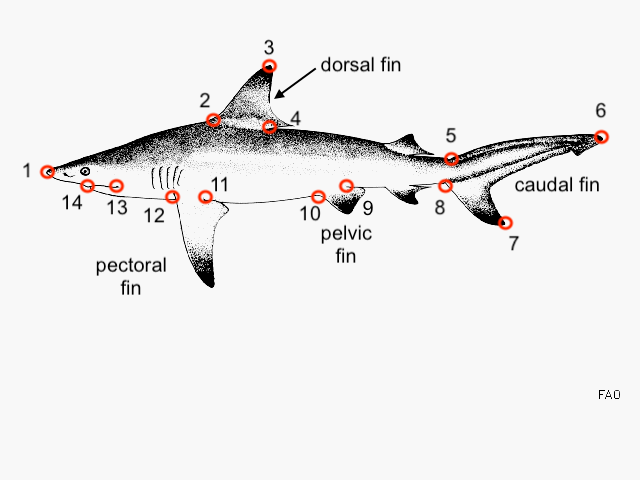class: center, middle, inverse, title-slide .title[ # Phase II: Using Our Toolbox ] .subtitle[ ## Module 5: SHARK! ] .author[ ### Dr. Christopher Kenaley ] .institute[ ### Boston College ] .date[ ### 2025/9/29 ] --- class: inverse, top # In class today <!-- Add icon library --> <link rel="stylesheet" href="https://cdnjs.cloudflare.com/ajax/libs/font-awesome/5.14.0/css/all.min.css"> .pull-left[ Today we'll .... - Kick off Module 5 (New Phase!!) - Introduce imageJ/FIJI - Workflow in Geometric Morphometrics ] .pull-right[  ] --- class: inverse, top <!-- slide 1 --> ## Module 5: First things first .pull-left[ - Download FIJI - url: https://imagej.net/software/fiji/downloads ] .pull-right[ <br> <br> <br> <br>  ] --- class: inverse, top <!-- slide 1 --> ## Module 5: Shark! .pull-left[ - The Selachii: an ancient radiation - Body shape: does habitat predict it? ] .pull-right[  ] Thomson, Keith Stewart, and Dan E Simanek. 1977. “Body Form and Locomotion in Sharks.” American Zoologist 17 (2): 343–54. --- <!-- slide 1 --> <center> <table> <tr> <td> <center> <img src="https://earthlife.net/wp-content/uploads/What-Is-A-Elasmobranch-1280x718-1.webp" alt="bull shark" height="150"/> <br> A white shark, <i>Carcharias carchardon</i>, typical of Group 1. <br> <br> </center> </td> <td> <img style="height: 20px; width: 20px"/> </td> <td> <center> <img src="https://biogeodb.stri.si.edu/sftep/resources/img/images/species/95_8407.jpg" alt="bull shark" height="150"/> <br> A bull shark, <i>Carcharhinus leucas</i>, typical of Group 2. <br> <br> </center> </td> </tr> <br> <br> <tr> <td> <center> <img src="https://upload.wikimedia.org/wikipedia/commons/0/04/Squalus_acanthias_stellwagen.jpg" alt="bull shark" height="150"/> <br> A dogfish of the genus <i>Squalus</i> typical of Group 3. <br> </center> </td> <td> <img style="height: 20px; width: 20px"/> </td> <td> <center> <img src="https://biogeodb.stri.si.edu/caribbean/resources/img/images/species/4437_2257.jpg" alt="bull shark" height="150"/> <br> A kitefin shark, <i>Dalatias licha</i>, typical of Group 4. <br> </center> </td> </tr> </table> </center> <br> <br> --- class: inverse, top ## Module 5: Shark! .pull-left[ - The Selachii: an ancient radiation - Body shape: does habitat predict it? - Sternes & Shimada (2020): only two groups, group B=many pelagic sharks ] .pull-right[  ] Sternes, Phillip C, and Kenshu Shimada. 2020. “Body Forms in Sharks (Chondrichthyes: Elasmobranchii) and Their Functional, Ecological, and Evolutionary Implications.” Zoology 140: 125799. --- class: inverse, top <!-- slide 1 --> ## Geometric Morphometrics .pull-left[ 1. Data collection: select landmarks of interest, usually through digitization of specimen images. 2. Data standardization: Make landmarks comparable across all specimens, usually through superimposition. 3. Analysis: choose a statistical approach appropriate to the questions. (Friday) 4. Interpretation: use the outcome of the statistical analysis to assess the original questions. (Friday) ] .pull-right[  ] --- class: inverse, top <!-- slide 1 --> ## Data collection: FIJI .pull-left[ - Using multipoint tool, digitize 14 points - Worflow - Use macro to save file  ] .pull-right[ - Open am image. - Select the multipoint tool. - Digitize the 14 landmarks you see above. - Measure the XY positions of these points (cmd/ctrl+m). - Select the macro tab and run the macro (cmd/ctrl+r). - Save the results to the appropriate directory. - Close the results and image tab (don’t save the image). ] --- class: inverse, top <!-- slide 1 --> ## Data collection: FIJI .pull-left[ - Using multipoint tool, digitize 14 points - Worflow - **Use macro to save file**  ] .pull-right[ ### Importance of metadata ```f = getTitle(); dir=getDirectory("Choose where to save data "); selectWindow("Results"); saveAs("Results", dir+f+"_.csv"); ``` Apmel_m0.gif `\(\rightarrow\)` Apmel_m0.gif_.csv ] --- class: inverse, top <!-- slide 1 --> ## Data standardization: superimposition .pull-left[ - generalized Procrustes analaysis (GPA)  ] .pull-right[ <!-- --> ]